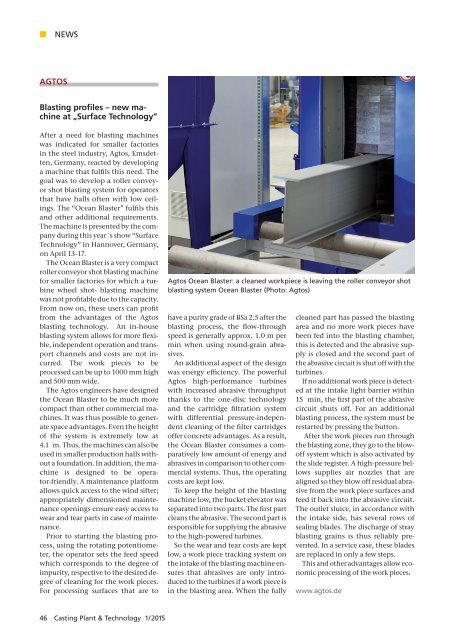CPT International 01/2015
The leading technical journal for the global foundry industry – Das führende Fachmagazin für die weltweite Gießerei-Industrie
The leading technical journal for the
global foundry industry – Das führende Fachmagazin für die
weltweite Gießerei-Industrie
Create successful ePaper yourself
Turn your PDF publications into a flip-book with our unique Google optimized e-Paper software.
NEWS<br />
AGTOS<br />
chine<br />
at „Surface Technology”<br />
After a need for blasting machines<br />
was indicated for smaller factories<br />
in the steel industry, Agtos, Emsdetten,<br />
Germany, reacted by developing<br />
a machine that fulfils this need. The<br />
goal was to develop a roller conveyor<br />
shot blasting system for operators<br />
that have halls often with low ceilings.<br />
The “Ocean Blaster” fulfils this<br />
and other additional requirements.<br />
The machine is presented by the company<br />
during this year´s show “Surface<br />
Technology” in Hannover, Germany,<br />
on April 13-17.<br />
The Ocean Blaster is a very compact<br />
roller conveyor shot blasting machine<br />
for smaller factories for which a turbine<br />
wheel shot- blasting machine<br />
was not profitable due to the capacity.<br />
From now on, these users can profit<br />
from the advantages of the Agtos<br />
blasting technology. An in-house<br />
blasting system allows for more flexible,<br />
independent operation and transport<br />
channels and costs are not incurred.<br />
The work pieces to be<br />
processed can be up to 1000 mm high<br />
and 500 mm wide.<br />
The Agtos engineers have designed<br />
the Ocean Blaster to be much more<br />
compact than other commercial machines.<br />
It was thus possible to generate<br />
space advantages. Even the height<br />
of the system is extremely low at<br />
4.1 m. Thus, the machines can also be<br />
used in smaller production halls without<br />
a foundation. In addition, the machine<br />
is designed to be operator-friendly.<br />
A maintenance platform<br />
allows quick access to the wind sifter;<br />
appropriately dimensioned maintenance<br />
openings ensure easy access to<br />
wear and tear parts in case of maintenance.<br />
Prior to starting the blasting process,<br />
using the rotating potentiometer,<br />
the operator sets the feed speed<br />
which corresponds to the degree of<br />
impurity, respective to the desired degree<br />
of cleaning for the work pieces.<br />
For processing surfaces that are to<br />
<br />
<br />
have a purity grade of BSa 2.5 after the<br />
blasting process, the flow-through<br />
speed is generally approx. 1.0 m per<br />
min when using round-grain abrasives.<br />
An additional aspect of the design<br />
was energy efficiency. The powerful<br />
Agtos high-performance turbines<br />
with increased abrasive throughput<br />
thanks to the one-disc technology<br />
and the cartridge filtration system<br />
with differential pressure-independent<br />
cleaning of the filter cartridges<br />
offer concrete advantages. As a result,<br />
the Ocean Blaster consumes a comparatively<br />
low amount of energy and<br />
abrasives in comparison to other commercial<br />
systems. Thus, the operating<br />
costs are kept low.<br />
To keep the height of the blasting<br />
machine low, the bucket elevator was<br />
separated into two parts. The first part<br />
cleans the abrasive. The second part is<br />
responsible for supplying the abrasive<br />
to the high-powered turbines.<br />
So the wear and tear costs are kept<br />
low, a work piece tracking system on<br />
the intake of the blasting machine ensures<br />
that abrasives are only introduced<br />
to the turbines if a work piece is<br />
in the blasting area. When the fully<br />
cleaned part has passed the blasting<br />
area and no more work pieces have<br />
been fed into the blasting chamber,<br />
this is detected and the abrasive supply<br />
is closed and the second part of<br />
the abrasive circuit is shut off with the<br />
turbines.<br />
If no additional work piece is detected<br />
at the intake light barrier within<br />
15 min, the first part of the abrasive<br />
circuit shuts off. For an additional<br />
blasting process, the system must be<br />
restarted by pressing the button.<br />
After the work pieces run through<br />
the blasting zone, they go to the blowoff<br />
system which is also activated by<br />
the slide register. A high-pressure bellows<br />
supplies air nozzles that are<br />
aligned so they blow off residual abrasive<br />
from the work piece surfaces and<br />
feed it back into the abrasive circuit.<br />
The outlet sluice, in accordance with<br />
the intake side, has several rows of<br />
sealing blades. The discharge of stray<br />
blasting grains is thus reliably prevented.<br />
In a service case, these blades<br />
are replaced in only a few steps.<br />
This and other advantages allow economic<br />
processing of the work pieces.<br />
www.agtos.de<br />
46 Casting Plant & Technology 1/2<strong>01</strong>5


















